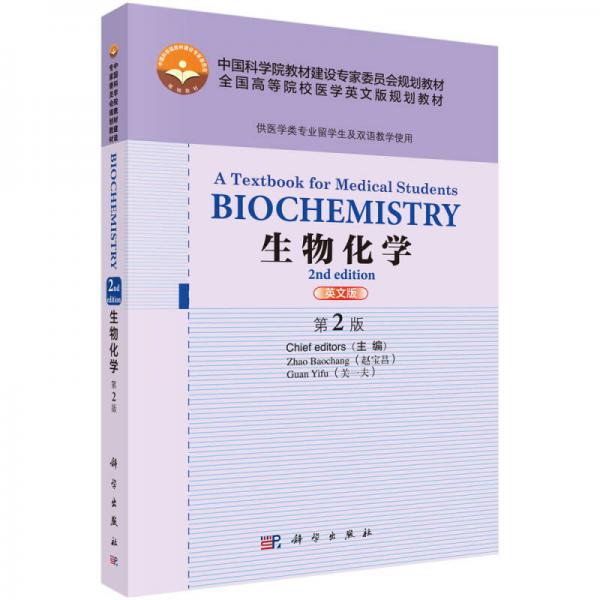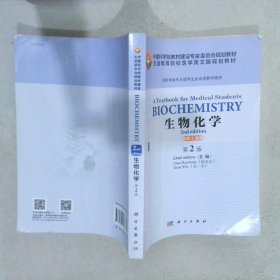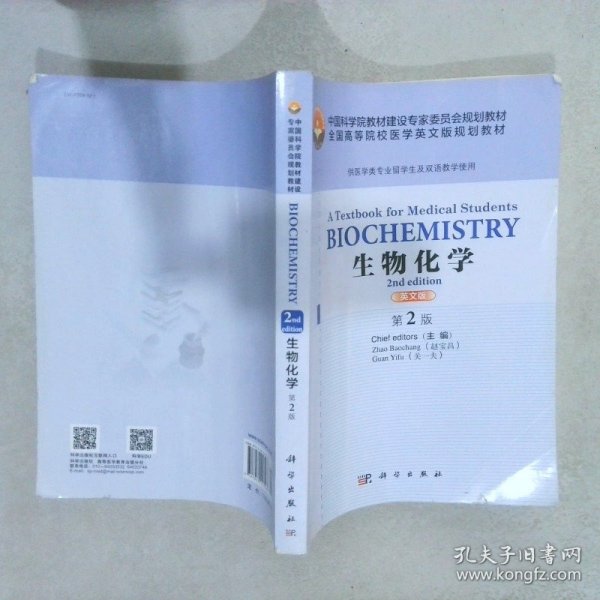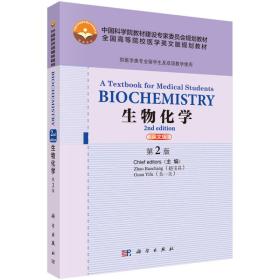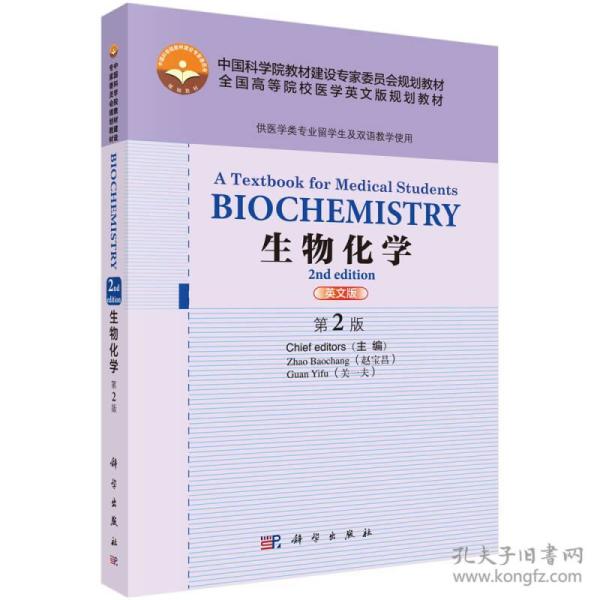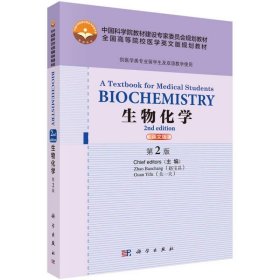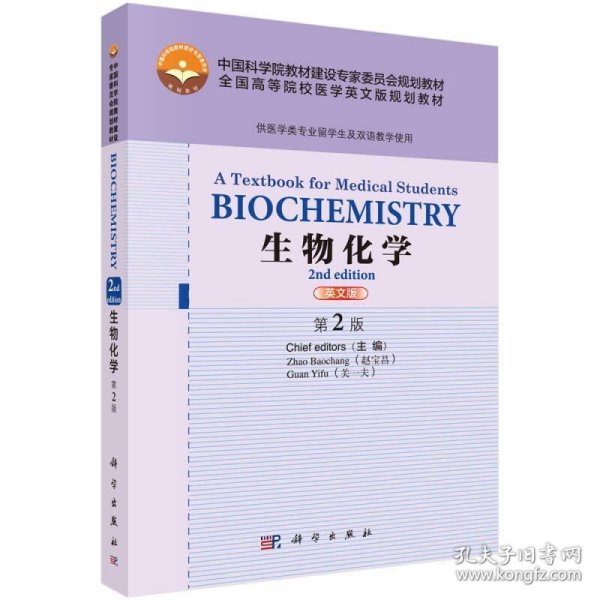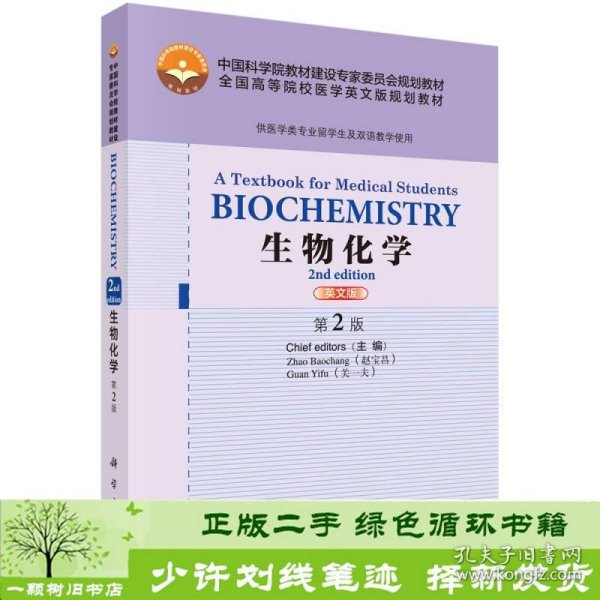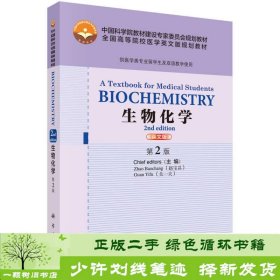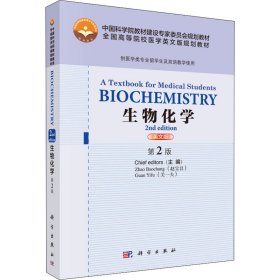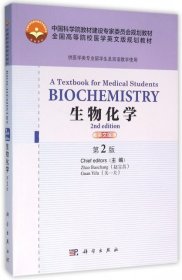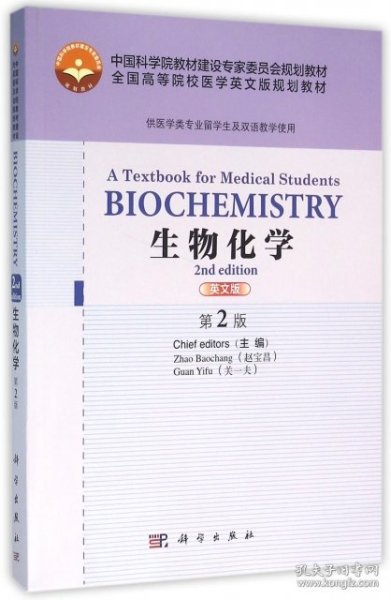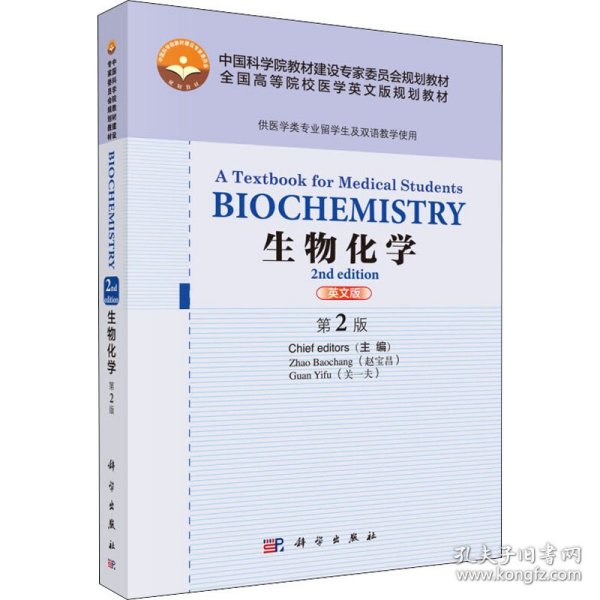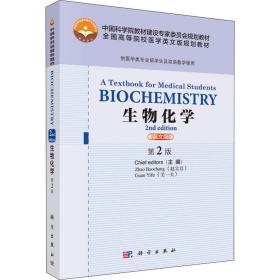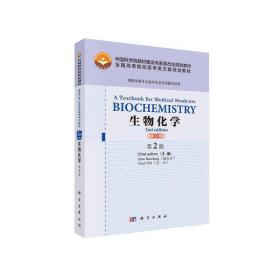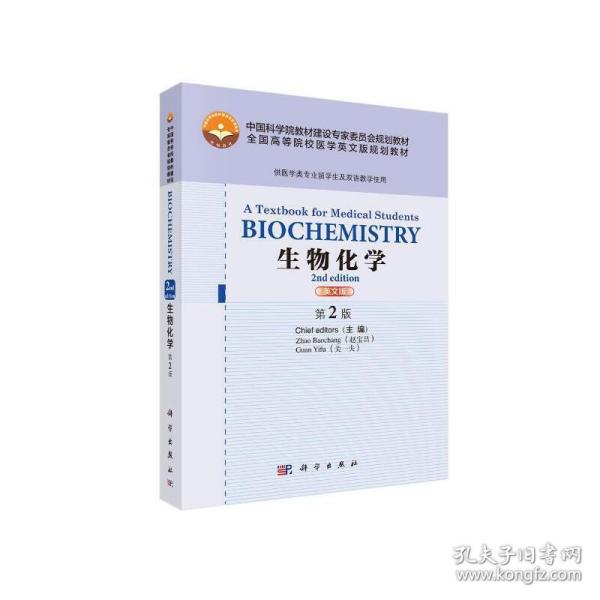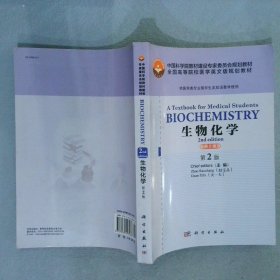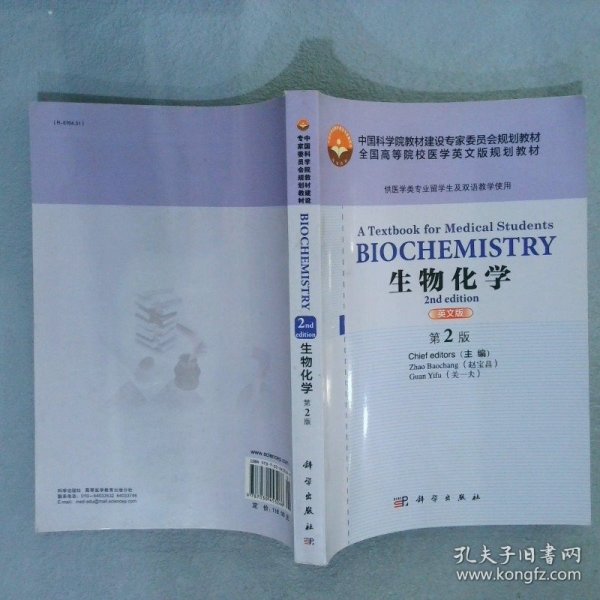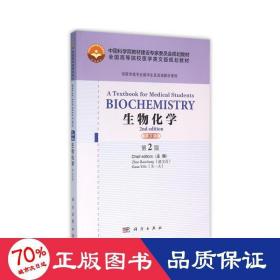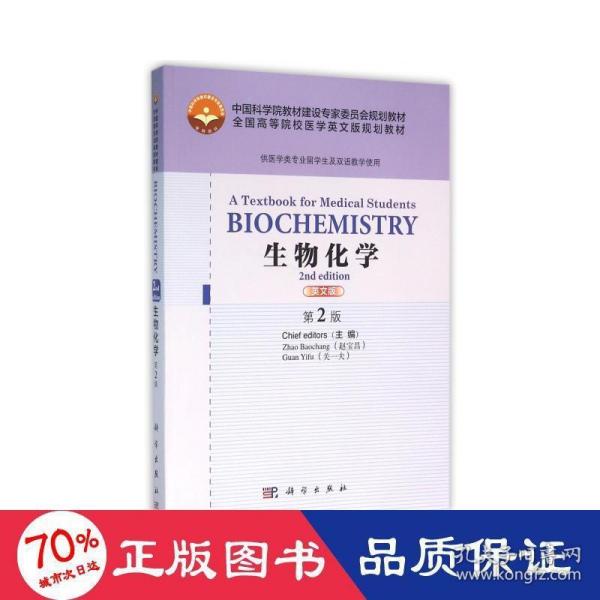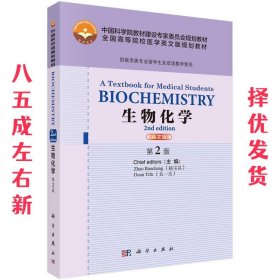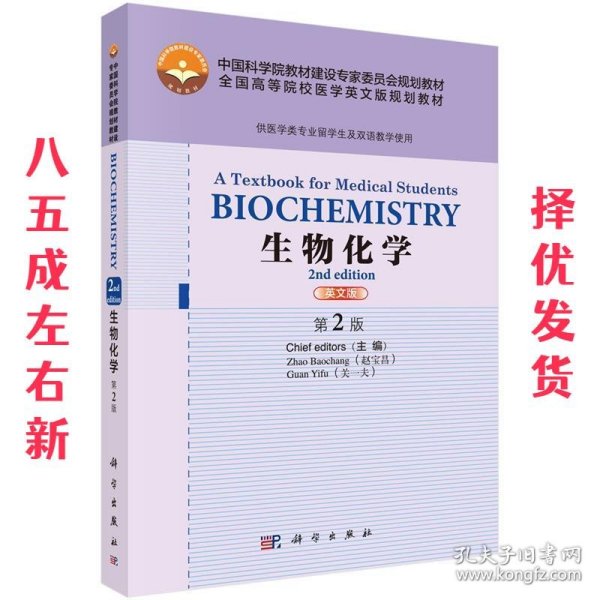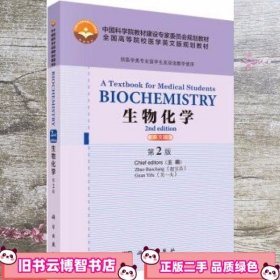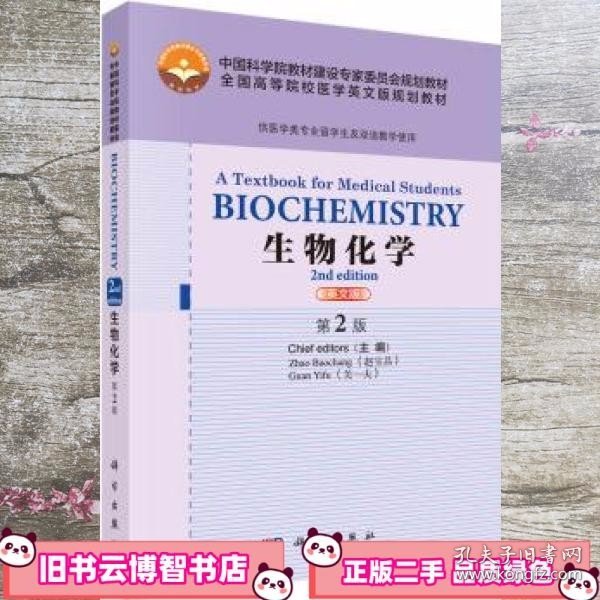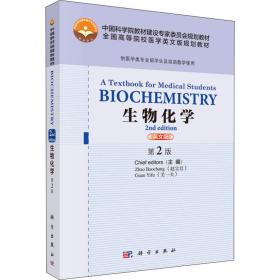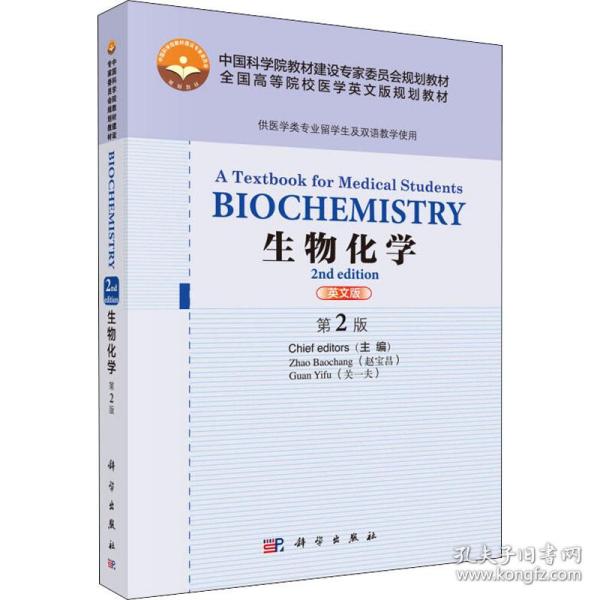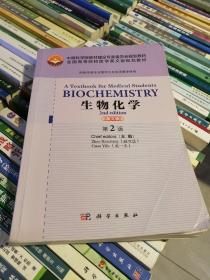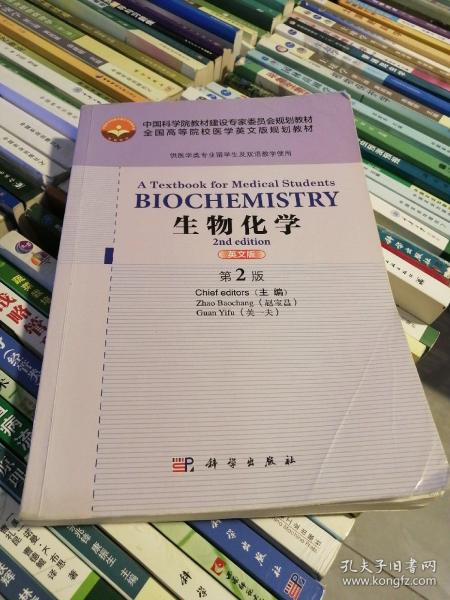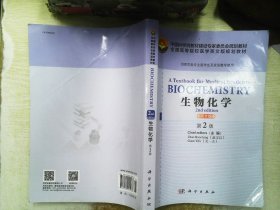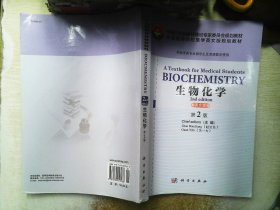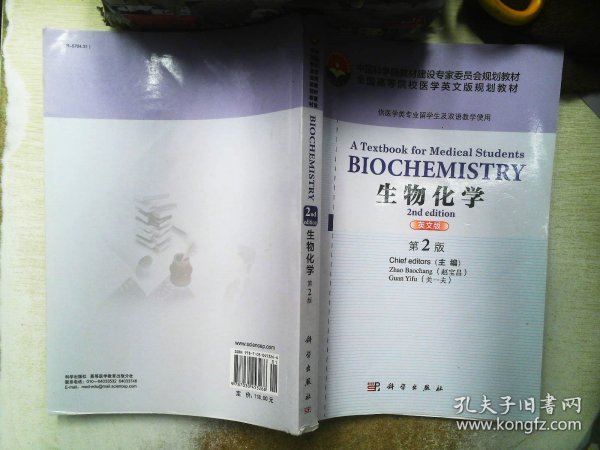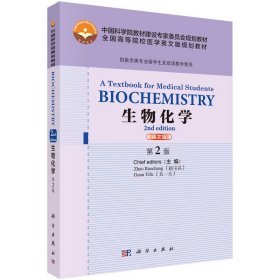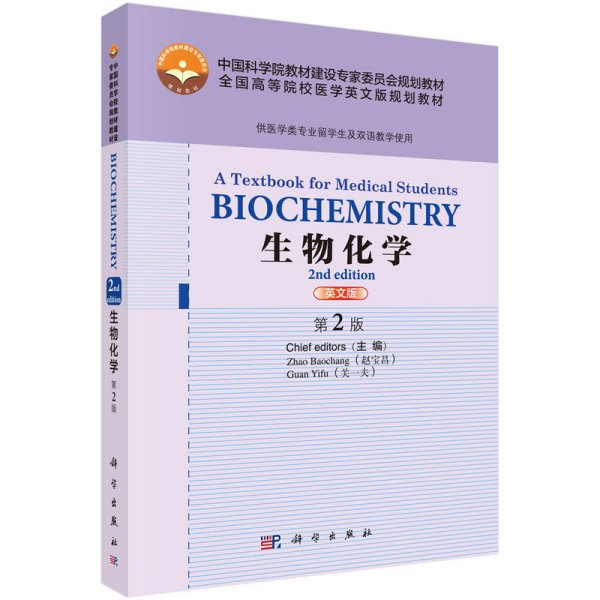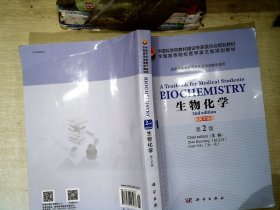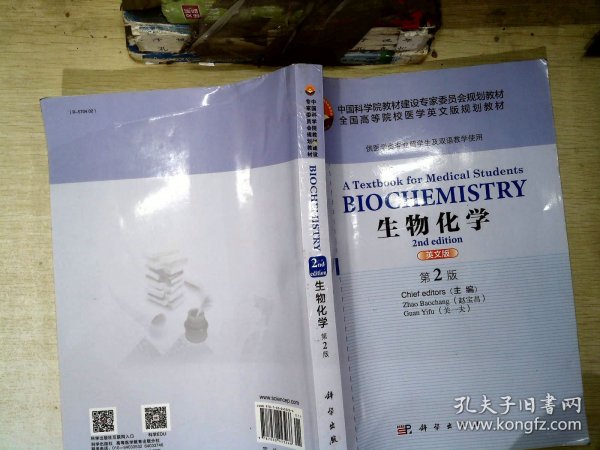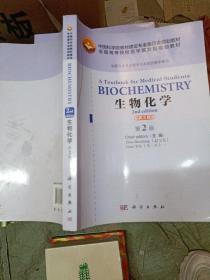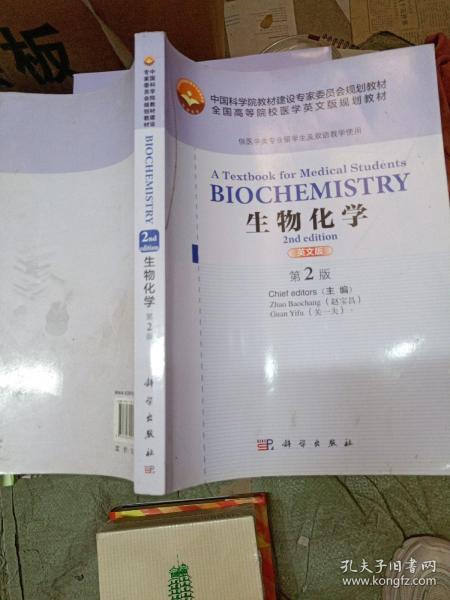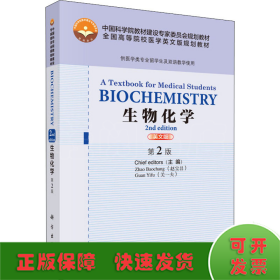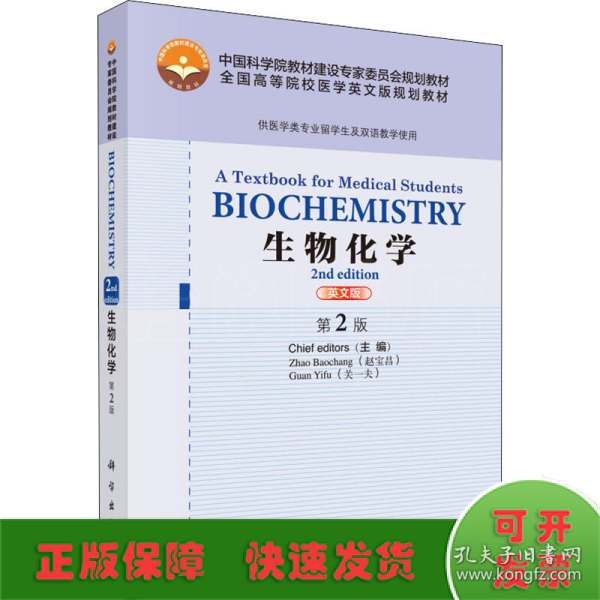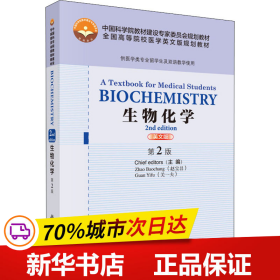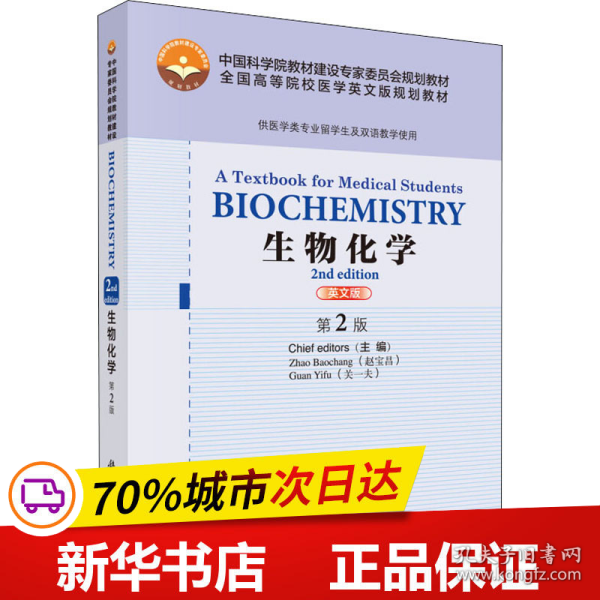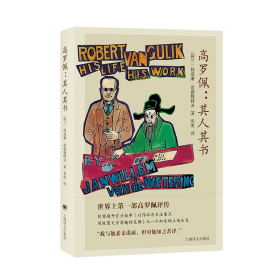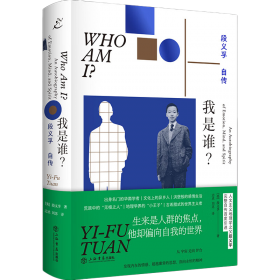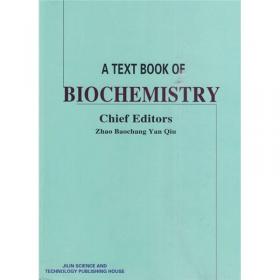Biochemistry:A Textbook for Medical Students,2n
作者:
赵宝昌
(Zhao Baochang) 编 , 关一夫
(Guan Yifu) 编
出版时间:
2016-03
版次:
2
ISBN:
9787030453266
定价:
79.00
装帧:
平装
开本:
16开
纸张:
胶版纸
页数:
382页
字数:
913千字
正文语种:
英语
53人买过
-
《Biochemistry:A Textbook for Medical Students,2n Edition(英文版)》是我国高等医学院校本科在华留学生和中、英双语教学的生物化学教科书,内容为医学专业类学生应该掌握的基础生物化学与分子生物学理论、基本知识和基本技能,同时也兼顾国家医师执业考试的要求。全书23章,内容分三个板块,分别包括蛋白质、核酸、维生素、酶和糖复合物的结构与功能;糖、脂、氨基酸、核苷酸和矿物质的代谢,以及生物氧化、血液和肝脏的代谢特点和代谢的整合与调节;DNA、RNA和蛋白质的生物合成、DNA损伤与修复、DNA技术、基因组学与蛋白质组学等组学,以及细胞信号转导和癌基因、肿瘤抑制基因和生长因子。全书共有插图342幅,表格67个。为了适应医学教学改革的需要,彰显医学生用生物化学教科书的医学专业特色,《Biochemistry:A Textbook for Medical Students,2n Edition(英文版)》第二版增添了生物化学与医学联系的知识框70个,在分子水平上对某些临床医学现象进行解读。
《Biochemistry:A Textbook for Medical Students,2n Edition(英文版)》还特别注重在华留学生和双语教学的需要.重要的英文专业名词和术语均在其后标有相应的中文,并在书后附有名词释义,对重要的术语给出简洁、准确的概念。各章后均有中、英文对照小结。
《Biochemistry:A Textbook for Medical Students,2n Edition(英文版)》适用于高等医学院校基础医学、临床医学、预防医学、口腔医学等各专业本科在华留学生和中、英双语教育的学生使用,也可作为从事本专业教师与研究人员的参考用书。 Introduction
Chapter 1 Structures and Functions of Proteins
1.1 Amino Acid Composition in Proteins
1.2 Molecular Structure of Proteins
1.3 Structure-Function Relationship of Proteins
1.4 Classification of Proteins
1.5 Protein Physicochemical Properties and Protein Exploration
Chapter 2 Structures and Functions of Nucleic Acids
2.1 Structural Units of Nucleic Acids——Nucleotides
2.2 Structures and Functions of DNA
2.3 Structures and Functions of RNA
2.4 Properties of Nucleic Acids
2.5 Nucleases
Chapter 3 Vitamins
3.1 Fat-soluble Vitamins
3.2 Water-soluble Vitamins
Chapter 4 Enzymes
4.1 Structure and Function of Enzymes
4.2 Properties and Catalytic Mechanisms of Enzymes
4.3 Kinetics of Enzyme-Catalyzed Reactions
4.4 Regulatory Enzymes
4.5 Nomenclature and Classification of Enzymes
4.6 Clinical Applications of Enzymes
Chapter 5 Glycoconjugates
5.1 Molecular Structures of Glycans
5.2 Structures and Functions of Glycoproteins
5.3 Structures and Functions of Proteoglycans
5.4 Structures and Functions of Glycolipids
Chapter 6 Biological Oxidation
6.1 Electron Transport Chain
6.2 Oxidative Phosphorylation
6.3 ATP and the Other High Energy Compounds
6.4 Selective Transport across the Inner Mitochondrial Membrane
6.5 Other Biological Oxidations
Chapter 7 Carbohydrate Metabolism
7.1 Digestion and Absorption of Carbohydrates
7.2 Anaerobic Degradation of Glucose
7.3 Aerobic Oxidation of Glucose
7.4 Pentose Phosphate Pathway
7.5 Glycogen Formation and Degradation
7.6 Gluconeogenesis
7.7 Blood Sugar and Its Regulation
Chapter 8 Lipid Metabolism
8.1 Fatty Acids and Derivatives of Polyunsaturated Fatty Acids
8.2 Digestion and Absorption of Lipids
8.3 Metabolism of Fats
8.4 Metabolism of Phospholipids
8.5 Metabolism of Cholesterol
8.6 Metabolism of Plasma Lipoproteins
Chapter 9 Protein Catabolism
9.1 Nutritional Roles of Dietary Proteins
9.2 Digestion, Absorption and Putrefaction of Dietary Proteins
9.3 Degradation of Protein in Cells
9.4 General Catabolism of Amino Acids
9.5 Metabolism of Ammonia
9.6 Individual Amino Acid Catabolism
Chapter 10 Nucleotide Metabolism
10.1 Biological and Medical Functions of Nucleotides
10.2 Degradation of Nucleic Acids
10.3 Metabolism of Purine Nucleotides
10.4 Metabolism of Pyrimidine Nucleotides
10.5 Deoxyribonucleotide Biosynthesis
10.6 Biosynthesis of Nucleoside Diphosphate and Nucleoside Triphosphate
10.7 Dysmetabolism of Nucleotides and Antimetabolites
Chapter 11 Blood Biochemistry
11.1 Plasma Proteins
11.2 Structure and Function of Albumin
11.3 Synthesis of Hemoglobin and Its Regulation
11.4 Metabolism of Blood Cells
Chapter 12 Liver Biochemistry
12.1 The Role of Liver in Material Metabolism
12.2 Hepatic Biotransformation
12.3 Metabolism of Bile Acid
12.4 Bile Pigment Metabolism and Jaundice
Chapter 13 Mineral Biochemistry
13.1 Calcium, Phosphorus, and Magnesium Metabolism
13.2 Trace Elements
Chapter 14 Integration and Regulation of Metabolism
14.1 Common Characteristics of Metabolism
14.2 Intereonnections of Metabolism
14.3 Metabolic Specializations of Some Organs
14.4 Regulatory Strategy of Metabolism
Chapter 15 DNA Biosynthesis
15.1 General Features of DNA Replication
15.2 Enzymology and Topology of DNA Replication
15.3 Replication of Prokaryotic Systems
15.4 Replication of Eukaryotic Systems
15.5 Reverse Transcription and Other Modes of DNA Replication
Chapter 16 DNA Damage and Repair
16.1 DNA Damage
16.2 Repair of DNA Damage
16.3 Significance of DNA Damage and Repair to DNA Damage
Chapter 17 RNA Biosynthesis and Processing
17.1 Overview of Transcription
17.2 Transcription in Prokaryotes
17.3 Transcription in Eukaryotes
17.4 Processing of Eukaryotic RNAs
Chapter 18 Protein Biosynthesis, Modification and Targeting
18.1 Machinery Involved in Translation
18.2 Amino Acid Activation
18.3 Protein Biosynthesis Journey
18.4 Protein Posttranslational Modifications and Targeting
18.5 Clinical Correlation of Protein Biosynthesis
Chapter 19 Regulation of Gene Expression
19.1 General Characteristics of Gene Expression
19.2 Regulation of Gene Expression in Prokaryotes
19.3 Regulation of Gene Expression in Eukaryotes
Chapter 20 DNA Technologies
20.1 Molecular Hybridization
20.2 DNA Sequencing
20.3 Polymerase Chain Reaction
20.4 Recombinant DNA Technology
20.5 Transgenesis and Gene Targeting
20.6 Gene Diagnosis and Gene Therapy
Chapter 21 Signal Transduetion
21.1 Signal Molecules
21.2 Receptors
21.3 Signal Transduction Pathways
21.4 Signal Transduction Network
21.5 Signal Transduction and Medicine
Chapter 22 Oncogenes, Tumor Suppressor Genes and Growth Factors
22.1 Oncogenes
22.2 Tumor Suppressor Genes
22.3 Growth Factors
Chapter 23 Genomics, Proteomics, and Other Omics
23.1 Genomics
23.2 Proteomics
23.3 Other Omics
23.4 Omics and Medicine
The Major References
Index
Glossary
-
内容简介:
《Biochemistry:A Textbook for Medical Students,2n Edition(英文版)》是我国高等医学院校本科在华留学生和中、英双语教学的生物化学教科书,内容为医学专业类学生应该掌握的基础生物化学与分子生物学理论、基本知识和基本技能,同时也兼顾国家医师执业考试的要求。全书23章,内容分三个板块,分别包括蛋白质、核酸、维生素、酶和糖复合物的结构与功能;糖、脂、氨基酸、核苷酸和矿物质的代谢,以及生物氧化、血液和肝脏的代谢特点和代谢的整合与调节;DNA、RNA和蛋白质的生物合成、DNA损伤与修复、DNA技术、基因组学与蛋白质组学等组学,以及细胞信号转导和癌基因、肿瘤抑制基因和生长因子。全书共有插图342幅,表格67个。为了适应医学教学改革的需要,彰显医学生用生物化学教科书的医学专业特色,《Biochemistry:A Textbook for Medical Students,2n Edition(英文版)》第二版增添了生物化学与医学联系的知识框70个,在分子水平上对某些临床医学现象进行解读。
《Biochemistry:A Textbook for Medical Students,2n Edition(英文版)》还特别注重在华留学生和双语教学的需要.重要的英文专业名词和术语均在其后标有相应的中文,并在书后附有名词释义,对重要的术语给出简洁、准确的概念。各章后均有中、英文对照小结。
《Biochemistry:A Textbook for Medical Students,2n Edition(英文版)》适用于高等医学院校基础医学、临床医学、预防医学、口腔医学等各专业本科在华留学生和中、英双语教育的学生使用,也可作为从事本专业教师与研究人员的参考用书。
-
目录:
Introduction
Chapter 1 Structures and Functions of Proteins
1.1 Amino Acid Composition in Proteins
1.2 Molecular Structure of Proteins
1.3 Structure-Function Relationship of Proteins
1.4 Classification of Proteins
1.5 Protein Physicochemical Properties and Protein Exploration
Chapter 2 Structures and Functions of Nucleic Acids
2.1 Structural Units of Nucleic Acids——Nucleotides
2.2 Structures and Functions of DNA
2.3 Structures and Functions of RNA
2.4 Properties of Nucleic Acids
2.5 Nucleases
Chapter 3 Vitamins
3.1 Fat-soluble Vitamins
3.2 Water-soluble Vitamins
Chapter 4 Enzymes
4.1 Structure and Function of Enzymes
4.2 Properties and Catalytic Mechanisms of Enzymes
4.3 Kinetics of Enzyme-Catalyzed Reactions
4.4 Regulatory Enzymes
4.5 Nomenclature and Classification of Enzymes
4.6 Clinical Applications of Enzymes
Chapter 5 Glycoconjugates
5.1 Molecular Structures of Glycans
5.2 Structures and Functions of Glycoproteins
5.3 Structures and Functions of Proteoglycans
5.4 Structures and Functions of Glycolipids
Chapter 6 Biological Oxidation
6.1 Electron Transport Chain
6.2 Oxidative Phosphorylation
6.3 ATP and the Other High Energy Compounds
6.4 Selective Transport across the Inner Mitochondrial Membrane
6.5 Other Biological Oxidations
Chapter 7 Carbohydrate Metabolism
7.1 Digestion and Absorption of Carbohydrates
7.2 Anaerobic Degradation of Glucose
7.3 Aerobic Oxidation of Glucose
7.4 Pentose Phosphate Pathway
7.5 Glycogen Formation and Degradation
7.6 Gluconeogenesis
7.7 Blood Sugar and Its Regulation
Chapter 8 Lipid Metabolism
8.1 Fatty Acids and Derivatives of Polyunsaturated Fatty Acids
8.2 Digestion and Absorption of Lipids
8.3 Metabolism of Fats
8.4 Metabolism of Phospholipids
8.5 Metabolism of Cholesterol
8.6 Metabolism of Plasma Lipoproteins
Chapter 9 Protein Catabolism
9.1 Nutritional Roles of Dietary Proteins
9.2 Digestion, Absorption and Putrefaction of Dietary Proteins
9.3 Degradation of Protein in Cells
9.4 General Catabolism of Amino Acids
9.5 Metabolism of Ammonia
9.6 Individual Amino Acid Catabolism
Chapter 10 Nucleotide Metabolism
10.1 Biological and Medical Functions of Nucleotides
10.2 Degradation of Nucleic Acids
10.3 Metabolism of Purine Nucleotides
10.4 Metabolism of Pyrimidine Nucleotides
10.5 Deoxyribonucleotide Biosynthesis
10.6 Biosynthesis of Nucleoside Diphosphate and Nucleoside Triphosphate
10.7 Dysmetabolism of Nucleotides and Antimetabolites
Chapter 11 Blood Biochemistry
11.1 Plasma Proteins
11.2 Structure and Function of Albumin
11.3 Synthesis of Hemoglobin and Its Regulation
11.4 Metabolism of Blood Cells
Chapter 12 Liver Biochemistry
12.1 The Role of Liver in Material Metabolism
12.2 Hepatic Biotransformation
12.3 Metabolism of Bile Acid
12.4 Bile Pigment Metabolism and Jaundice
Chapter 13 Mineral Biochemistry
13.1 Calcium, Phosphorus, and Magnesium Metabolism
13.2 Trace Elements
Chapter 14 Integration and Regulation of Metabolism
14.1 Common Characteristics of Metabolism
14.2 Intereonnections of Metabolism
14.3 Metabolic Specializations of Some Organs
14.4 Regulatory Strategy of Metabolism
Chapter 15 DNA Biosynthesis
15.1 General Features of DNA Replication
15.2 Enzymology and Topology of DNA Replication
15.3 Replication of Prokaryotic Systems
15.4 Replication of Eukaryotic Systems
15.5 Reverse Transcription and Other Modes of DNA Replication
Chapter 16 DNA Damage and Repair
16.1 DNA Damage
16.2 Repair of DNA Damage
16.3 Significance of DNA Damage and Repair to DNA Damage
Chapter 17 RNA Biosynthesis and Processing
17.1 Overview of Transcription
17.2 Transcription in Prokaryotes
17.3 Transcription in Eukaryotes
17.4 Processing of Eukaryotic RNAs
Chapter 18 Protein Biosynthesis, Modification and Targeting
18.1 Machinery Involved in Translation
18.2 Amino Acid Activation
18.3 Protein Biosynthesis Journey
18.4 Protein Posttranslational Modifications and Targeting
18.5 Clinical Correlation of Protein Biosynthesis
Chapter 19 Regulation of Gene Expression
19.1 General Characteristics of Gene Expression
19.2 Regulation of Gene Expression in Prokaryotes
19.3 Regulation of Gene Expression in Eukaryotes
Chapter 20 DNA Technologies
20.1 Molecular Hybridization
20.2 DNA Sequencing
20.3 Polymerase Chain Reaction
20.4 Recombinant DNA Technology
20.5 Transgenesis and Gene Targeting
20.6 Gene Diagnosis and Gene Therapy
Chapter 21 Signal Transduetion
21.1 Signal Molecules
21.2 Receptors
21.3 Signal Transduction Pathways
21.4 Signal Transduction Network
21.5 Signal Transduction and Medicine
Chapter 22 Oncogenes, Tumor Suppressor Genes and Growth Factors
22.1 Oncogenes
22.2 Tumor Suppressor Genes
22.3 Growth Factors
Chapter 23 Genomics, Proteomics, and Other Omics
23.1 Genomics
23.2 Proteomics
23.3 Other Omics
23.4 Omics and Medicine
The Major References
Index
Glossary
查看详情
-
生物化学英文版第2版
正版书籍 高温消毒 放心购买 17点前订单当天发货 书名于图片不符时以图片为准
八五品
广东省东莞市
平均发货9小时
成功完成率93.6%
-
八五品
山东省枣庄市
平均发货8小时
成功完成率88.75%
-
九品
北京市昌平区
平均发货22小时
成功完成率87.14%
-
八五品
山东省济南市
平均发货9小时
成功完成率89.56%
-
八五品
山东省枣庄市
平均发货10小时
成功完成率86.7%
-
全新
广东省广州市
平均发货35小时
成功完成率72.95%
-
八五品
重庆市沙坪坝区
平均发货9小时
成功完成率74.32%
-
八五品
重庆市沙坪坝区
平均发货9小时
成功完成率74.32%
-
全新
北京市通州区
平均发货9小时
成功完成率87.44%
-
全新
江苏省无锡市
平均发货14小时
成功完成率87.17%
-
八五品
天津市武清区
平均发货13小时
成功完成率94.37%
-
全新
天津市西青区
平均发货14小时
成功完成率89.93%
-
全新
广东省广州市
平均发货19小时
成功完成率86.79%
-
全新
江苏省南京市
平均发货15小时
成功完成率82.22%
-
全新
山东省潍坊市
平均发货16小时
成功完成率80.84%
-
生物化学
正版新书 新华官方库房直发 可开电子发票
全新
江苏省南京市
平均发货15小时
成功完成率82.22%
-
全新
江苏省无锡市
平均发货9小时
成功完成率94.18%
-
全新
四川省成都市
平均发货23小时
成功完成率88.3%
-
生物化学英文版第2版
正版书籍 高温消毒 放心购买 17点前订单当天发货 书名于图片不符时以图片为准
九品
广东省东莞市
平均发货9小时
成功完成率94.38%
-
生物化学英文版第2版
正版书籍 高温消毒 放心购买 17点前订单当天发货 书名于图片不符时以图片为准
九品
广东省东莞市
平均发货9小时
成功完成率91.97%
-
生物化学英文版第2版
正版书籍 高温消毒 放心购买 17点前订单当天发货 书名于图片不符时以图片为准
九品
广东省东莞市
平均发货8小时
成功完成率93.34%
-
生物化学英文版第2版
正版书籍 高温消毒 放心购买 17点前订单当天发货 书名于图片不符时以图片为准
九品
广东省东莞市
平均发货9小时
成功完成率92.58%
-
八五品
福建省福州市
平均发货10小时
成功完成率66.67%
-
全新
北京市丰台区
平均发货26小时
成功完成率87.13%
-
八五品
河南省鹤壁市
平均发货23小时
成功完成率88.53%
-
八五品
河南省鹤壁市
平均发货20小时
成功完成率90.88%
-
八五品
浙江省杭州市
平均发货10小时
成功完成率93.52%
-
八五品
四川省成都市
平均发货11小时
成功完成率91.79%
-
八五品
重庆市沙坪坝区
平均发货12小时
成功完成率90.3%
-
生物化学
正版新书 新华官方库房直发 可开电子发票
全新
江苏省南京市
平均发货7小时
成功完成率98.23%
-
生物化学
正版新书 新华官方库房直发 可开电子发票
全新
江苏省南京市
平均发货7小时
成功完成率95.88%
-
八五品
北京市通州区
平均发货13小时
成功完成率95.62%
-
全新
广东省广州市
平均发货18小时
成功完成率87.57%
-
八五品
重庆市沙坪坝区
平均发货10小时
成功完成率91.32%
-
全新
北京市西城区
平均发货16小时
成功完成率91.55%
-
全新
江苏省南京市
平均发货20小时
成功完成率43.4%
-
八五品
重庆市沙坪坝区
平均发货11小时
成功完成率67.07%
-
全新
四川省成都市
平均发货16小时
成功完成率81.56%
-
九品
广东省东莞市
平均发货7小时
成功完成率96.16%
-
九品
广东省东莞市
平均发货7小时
成功完成率96.16%
-
九品
江西省南昌市
平均发货20小时
成功完成率86.13%
-
七五品
广东省东莞市
平均发货7小时
成功完成率96.31%
-
九五品
河南省郑州市
平均发货9小时
成功完成率92.03%
-
九五品
湖南省长沙市
平均发货13小时
成功完成率91.53%
-
全新
广东省广州市
平均发货6小时
成功完成率90.08%
-
全新
江苏省无锡市
平均发货15小时
成功完成率94.5%
-
八五品
江西省南昌市
平均发货5小时
成功完成率91.49%
-
全新
河北省保定市
平均发货15小时
成功完成率90.79%
-
全新
北京市朝阳区
平均发货9小时
成功完成率96.86%
-
全新
天津市河东区
平均发货24小时
成功完成率90.39%

 占位居中
占位居中

